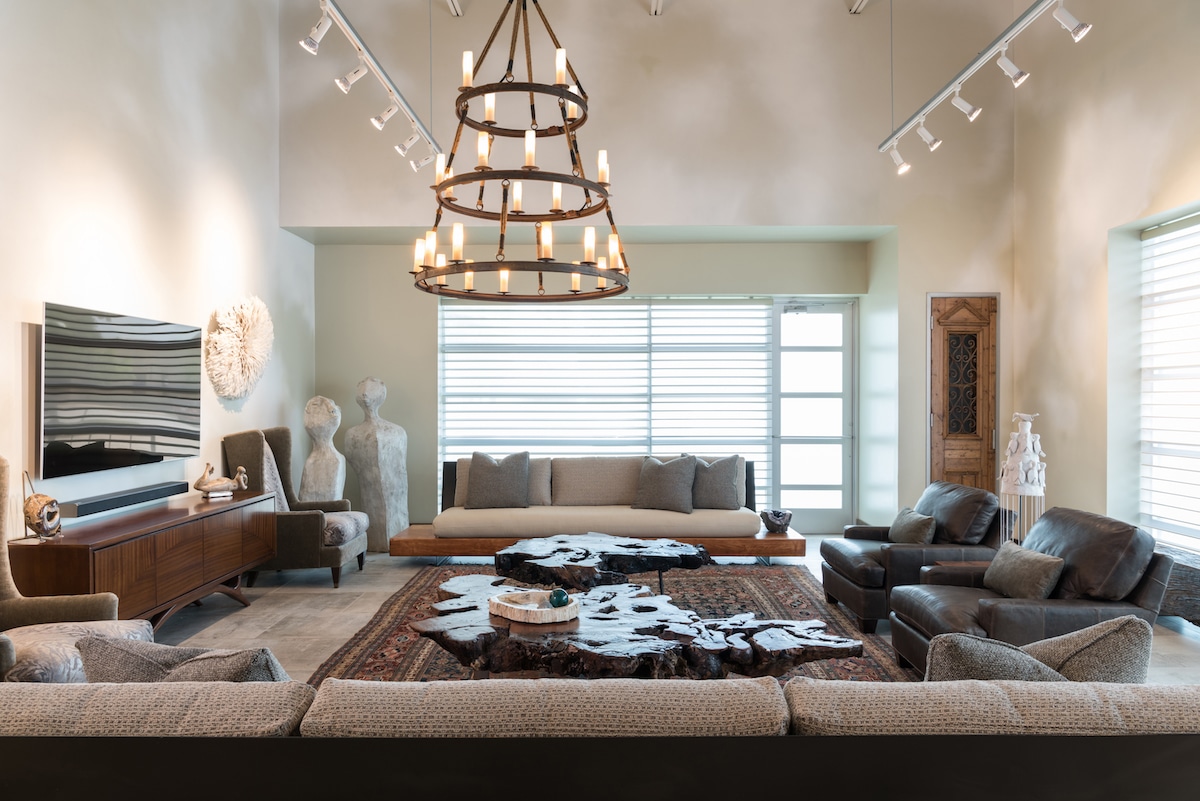Story at a glance:
- Sustainable Furnishings Council Executive Director Susan Inglis on why transparency in the furniture industry is a must.
- The Sustainable Furnishings Council’s “What’s It Made Of” initiative encourages transparency in the supply chain.
- Room & Board, Mitchell Gold + Bob Williams, and Saatva are among the companies leading by example.
A piece of modern sustainable furniture brings so much more to a space than its looks, and it is this truth that drives Susan Inglis in her work with the Sustainable Furnishings Council (SFC).
“Even though the residential furnishings industry is relatively small, it is extremely impactful,” says Inglis, who serves as the executive director and resident expert of the council.
Inglis helped found the council in 2006 when Peruvian furniture manufacturer Jerry Cooklin “greened up” his operations, as Inglis describes, and realized he should expand the conversation beyond his own showroom.
Cooklin called on Inglis—founder and owner of From The Mountain, a company that imports hand-spun cashmere yarn from Afghanistan, providing safe income for more than 100 women there—and other industry experts for a meeting. A month later, the SFC was born. Inglis now manages all programming and outreach and teaches most of the classes offered by the SFC.
Operating under the motto “healthy environments inside and out,” the council educates manufacturers, suppliers, and designers about reducing their environmental impact and producing furnishings that are safe and healthy for consumers.
The council also encourages consumers to ask the right questions and look out for harmful chemicals when making furnishing purchases. Their “What’s It Made Of?” initiative is putting pressure on the industry to know exactly where and how their products are produced.
“It is about being cognizant of our decisions,” Inglis says. “And not polluting our environment anymore than is absolutely necessary.”

Susan Inglis. Courtesy of Sustainable Furnishings Council
Inglis recently took the time to share her enthusiasm for sustainable design and industry transparency with us in this interview.
gb&d: Tell us about the council. How are you changing the world of furnishings?
Inglis: To put it romantically, our mission is to sustain a healthy future inside and out. More than anything, we are an educational organization. We provide consumers with a handy tool on our website where they can look for specific products and who is producing them in an environmentally conscious way. Consumers are directed to SFC members, each of whom has made its own corporate commitment to sustainability and transparency. We provide information on what questions to ask and things to look out for when shopping for furniture.
As far as for the companies themselves, we provide nine education programs to help companies reduce their footprint in various ways. We have five categories of resources on our website for businesses to use, including waste reduction and recycling, energy use reduction, health and environmental safety, material choices, and awareness and truth in advertising. We need to be aware of the decisions we are making in residential furniture, and there is no better way to do that than to join the movement and be involved in what the SFC is doing.
gb&d: Why should people be concerned about how the furnishings in their homes are made?
Inglis: There are a lot of chemicals hidden in residential furniture and present in our homes that are making us sick and polluting the rest of the world. Because it is a smallish industry made up of a lot of small businesses, it is a fragmented and global industry. Frequently the materials that go into making a sofa come from one continent and might be processed on another, manufactured on another, and probably sold on yet another. The furnishings industry has a large footprint just in the transportation and the fossil fuels of moving things from one place to another.
Another reason to be concerned is that we put a finish and glue on everything. In our industry the adhesives and finishings are the source of many volatile organic compounds that pollute our environment. If it gives you a headache when you walk into the store, you should be concerned. It is affecting you and your health. Our choices are very impactful on how much pollution we have in our indoor environment and atmosphere.

Mitchell Gold + Bob Williams works with the Sustainable Furnishings Council to give customers better products. Photo courtesy of Mitchell Gold + Bob Williams
gb&d: How has the council evolved over the years?
Inglis: We have grown, and that is good news. When we started we had 40 members and now we have almost 400. Each member has made improvements in their operations and up and down the supply chain. We don’t claim to take credit for all of it. Over the last 11 years there have been a lot of changes in the world and a growing awareness, especially recently. Consumer research has shown us how consumer concern over our environmental impact is growing, including with purchases of furniture and other products, which is great. There is also a continued need for the most basic information about reducing the environmental footprint.
When we started we had just one sort of membership, but we soon developed a recognition program for companies that are implementing a lot of best practices for sustainability. We have created strict requirements that companies have to meet in order to earn that recognition, and we have developed an accredited certified sustainability educational program called GREENleaders.
We also recently completed another of our annual #GetYourGreenOn interior design competition, which featured products from SFC-member manufacturers and suppliers, and acknowledges interior design professionals who set high environmental standards and tirelessly ask their partners and suppliers, “What’s it made of?”
gb&d: You recently completed your eighth consumer survey. What surprised you? What needs work?
Inglis: The levels of concern were surprising. People are concerned about the damage to their health. Indoor air quality is a huge concern, and global warming. People are worried about asthma and what is making families sick. For years when we have been doing this research, we have known that lack of awareness is why people don’t buy more eco-friendly furniture. 90% of the people surveyed in this most recent study said they want to buy eco-friendly. That is everyone. It was very surprising. It made me think we need to help our members tell their stories even better so consumers know what choices they have, and they have more access to the choices that are out there.
gb&d: What are people looking for when shopping for furnishings?
Inglis: People are looking for an authentic eco story—one they can relate to. They understand some of the certifications—especially the ones related to sustainably harvested wood—and are willing to pay a tiny bit more for that certification. They are also looking for a product that suits their taste, is in their budget, and is good quality. Part of what they consider to be good quality is healthy for their families and for the environment. We have found that people are especially concerned about chemical inputs and materials used when shopping for children’s furniture.

Paola McDonald of Olamar Interiors received SFC’s 2016 Sustainable Design Excellence Award. Photo courtesy of Sustainable Furnishings Council
gb&d: What does it mean to be environmentally safe?
Inglis: It means different things to different people and different companies. We need to do all we can as people to reduce our impact. The planet is in enough trouble. We need to make educated choices in production and consumption.
gb&d: Tell us about the “What’s It Made Of?” initiative. How is it leading to change?
Inglis: That is really exciting. We have a lot of companies working with wood, upholstery, foam, et cetera becoming more aware and asking what alternatives are available to them. It is frequently something they haven’t thought about. It encourages transparency in the supply chain. Some companies have already been working hard to know exactly what goes into their products, but for others this is a new idea to get any information on what it is made of. We have a lot of companies coming to us with questions about common harmful chemicals and people are seeking alternatives. We are really excited about it all.
gb&d: How is the council making products greener? Who are the leaders in producing products that are environmentally safe?
Inglis: Our work is resulting in greener products because producers, manufacturers, and companies are learning more about what consumers are looking for at each stage. They are learning what questions they need to be asking and what answers they should be looking for at each part of the process. They are also learning they can build their businesses by getting better answers to their questions. They are learning people are willing to pay more if they know more.
We have great leaders in the industry—just look at our member list. We have many companies recognized as exemplary that have excelled at making positive changes. At the top of the list are Room & Board, Mitchell Gold + Bob Williams, and Saatva, but they aren’t the only ones. We also suggest consumers look at the sort of questions to ask and answers to look for on our website and consider those wherever they are shopping. It could be the store closest to you is also deserving of recognition but hasn’t sought it.
gb&d: What do we need to do to make real progress in the industry?
Inglis: Making real progress in reducing the furniture industry’s environmental footprint will involve a conscientious effort on the part of all specifiers to reduce unsustainable inputs, including wood from unsustainable sources, as well as harmful chemical inputs in the production and finishing of furnishing products. It is up to the specifiers to ask, but real progress will also involve greater transparency in our supply chains. In the past not enough questions have been asked about the consequences of our choices in materials and processes. We need to learn a new habit, asking, “What’s it made of?” and insisting on satisfactory answers.




